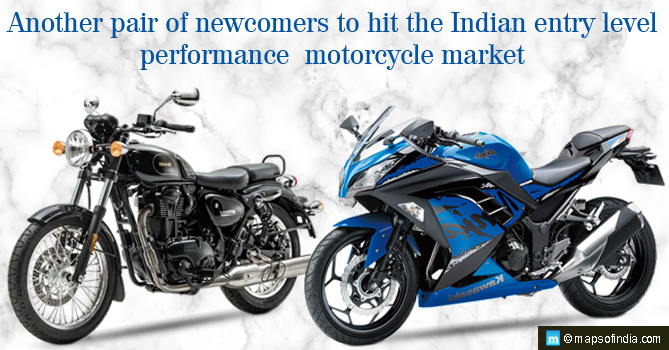
Benelli Imperiale 400
Benelli has come up with yet another addition to its India portfolio, and it is the most affordable one again. It’s called the Imperiale 400 and is a cruiser motorcycle with retro styling. Priced just below that of the Scrambler 250, the Imperiale aims to challenge the likes of 373cc Bajaj Dominar and the Royal Enfield Bullet 350cc.
Styling
The motorcycle is inspired from the design of the 1950 Benelli Imperiale 125. It gets a halogen powered headlight in the classic round shape and an analogue instrument cluster comprising two identical pods. The tank is shaped like a teardrop and is entirely yesteryear in appeal. The motorcycle speaks of the time gone by when function preceded form, and styling was minimalistic. It does have tank pads on either side near the rider’s end to work as thigh grips, but that’s precisely what Royal Enfield motorcycles have too, and except for the way that the body and trims are styled, it looks awfully like one too. Except for the Headlamp and cluster arrangements – they will remind us more of the Yamahas. Similarly, are the split seats styled, and the pea-shooter exhaust could be from any of the motorcycles that were sold in the Indian market of the eighties and nineties. It isn’t that the bike doesn’t look right, it’s just that from Benelli, one would expect more, and imitating the motorcycles of that era on almost every parameter doesn’t seem to have had the desired effect.
Powertrain
The Imperiale gets an air-cooled Overhead camshaft (OHC) 374 cc single-cylinder BSVI compliant petrol engine. It has been mated to their six-speed gearbox, and the unit manages to produce a peak power figure of 20.6 bhp at 5500 revolutions per minute and 29 Nm of peak torque at 4500 revolutions per minute.
Suspension
The engine rests in Benelli’s conventional double-cradle frame which is supported by a pair of 41 mm telescopic shock absorbers at the frontal section, and a pre-load adjustable set of twin shock absorbers at the rear. Braking is controlled by a single 300mm disc with a dual-piston calliper in the front, and a 240 mm disc with a single-piston calliper in the back.
No ABS or cool electronics here as the company probably needs the bike to feel its character of a classic as well.
With an unladen weight of 205 kgs, the Imperiale is 11 kgs heavier than its rival – the Bullet 350 which weighs 194 kgs. Try pushing that one when you run out of fuel!
Colours and Pricing
Unlike its competition, the Benelli Imperiale will only come in three colours – Red, Black and Silver. All other features are standard on the one single variant that the company has to offer.
The only parameter where Benelli seems to have latched on pretty close to the mark is the pricing. At 1.69 lakh, the Imperiale coincides exactly with the Classic 350’s price range and is the only way it can challenge this rival at all.
Kawasaki Ninja ZX-25R
Debuted at the 2019 Tokyo Motor Show, the quarter-litre Kawasaki Ninja ZX-25R is being nicknamed the “young rider’s dream” by some magazines. The bike is expected to have a power output of over 50 bhp. For this reason, it has generated anticipation and excitement at quite a rate and enthusiasts are loving the hype and exhilaration being built up before the official market launch of the motorcycle.
Styling
Design inspiration is very visibly from the flagship Ninja siblings. Still, a few key elements like the tubular steel trellis, and the aluminium full-wing swing arm scream H2R, and they are among the features that make this bike jaw-dropping.
With its launch, the company will have revisited and revived its in-line four-cylinder quarter-litre segment, which was all the rave back in the eighties and nineties with performance and technology being on their side. Their motorcycles had an added edge overall market rivals owing to the advanced anatomy of their functional systems.
Power and Technology
Further on that note, the ZX-25R rides on an in-line four-cylinder 249 cc liquid-cooled, fuel-injected engine and while it’s ancestors produced brake horsepower figures ranging in the forties, this latest offspring might go well over fifty. Mated to a six-speed transmission, the bike promises to pack quite the punch even for the seasoned rider for most will not be expecting what it serves them. Exact figures on torque and peak power have not been disclosed yet, and we can’t wait to get our hands on one to get a thorough understanding of how well it fills the said shoes.
One can expect quite a few electronic nitty-gritty as both performance enhancers, and user interface functions from the new baby Kwacker.
When can we expect it?
Kawasaki plans to manufacture the bike at their production facility in Indonesia and also commence the first round of sales from there. Based on the reach and response in that particular region, they will then expand towards the rest of the Asian continent. Sadly, that means the Indian market is going to have to wait for it, possibly till the second quarter of 2020, but the silver lining is that it’s still coming!





